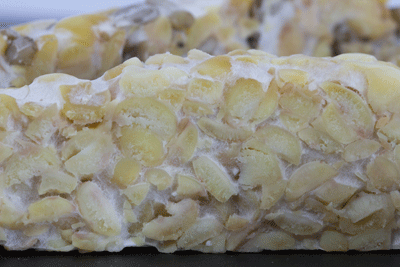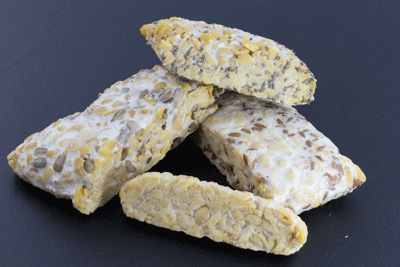By Professor Steve Flint
Tempeh (pronounced TEM-pay) is a popular Indonesian food consisting simply of fermented soybeans, or occasionally other legumes or grains. The beans are tender cooked and fermented by Rhizopus oligosporus mould until the beans have been knitted together by dense cottony growths called mycelia.
Tempeh is usually sliced into thin patties or fingers and fried until golden brown. Used as a base ingredient for such products, tempeh has been described as reminiscent of southern fried chicken or seafood fillets with an aroma described as nutty, cheesy, or mushroomy. Tempeh is high in protein averaging at 19.5 percent, which compares well with chicken (21 percent) and beef (20 percent), and is the highest vegetarian source of vitamin B12 making it one of the best vegetarian alternatives to meat1. Even if you are not vegetarian, products like tempeh can offer a pleasant and healthy variation to the average diet.
Health benefits of tempeh
Tempeh contains no cholesterol, is high in polyunsaturated fats, and has no salt, making it a very heart healthy replacement for meat. However, tempeh also has some other unique advantages to health that result from the fermentation process.
Tempeh is highly digestible, as the fermentation process releases enzymes that break down the components of the soy making them easily absorbed. Consequently tempeh has a higher nutritional quality than the soybeans used to make it1. The allergic response to soy proteins in sensitive individuals is greatly reduced in tempeh. This is because the proteins in soybeans are broken into smaller pieces by enzymes, and these smaller pieces cannot be recognised by the immune system. The immune response to tempeh is reduced by 66 percent compared to unfermented soy2, and thus people who are only mildly allergic to soy may be able to enjoy tempeh.
Another noted effect of soybean fermentation is the production of antioxidants3. The fermentation process results in a higher antioxidant content in tempeh than is naturally present in unfermented soybeans. The antioxidants are not as potent as commercially available antioxidants, but they are all natural and present in high concentrations. It is a widely held belief that antioxidants can protect against cancer because of their ability to deactivate free radicals.
A study on the effects of tofu intake on memory4, found that regular tofu intake resulted in a worse memory whereas regular tempeh consumption was linked to an improved memory. The mechanism for this has not been identified, but it is believed that the fermentation process is responsible for this marked difference. The Handbook of fermented functional foods (5) describes how some anti-nutritional factors of soybeans are inactivated, while beneficial isoflavonoids become easier to absorb after fermentation.
Tempeh is available in New Zealand but is not consumed widely. In recent years our students have manufactured tempeh and prepared products such as sausages and burgers using tempeh as the base ingredient. These products have been well received by sensory panellists. Tempeh is well worth considering as an alternative source of dietary protein.
1) The book of Tempeh. W. Shurtleff and Aoyagi, A. Ten speed press, 1979 173 pages.
2) Frias, J, Song, YS, Martinez-Villaluenga, C, De Mejia, EG, Vidal-Valverde, C. 2008. Immunoreactivity and amino acid content of fermented soybean products. Journal of Agricultural and Food Chemistry. 56(1): 99-105.
3) Lee, YL, Yang, JH, Mau, JL. 2008. Antioxidant properties of water extracts from Monascus fermented soybeans. Food Chemistry. 106(3): 1128-1137.
4) High tofu intake is associated with worse memory in elderly Indonesian men and women. Author(s): Hogervorst E (Hogervorst, E.)1, Sadjimim T (Sadjimim, T.)3, Yesufu A (Yesufu, A.)1, Kreager P (Kreager, P.)2, Rahardjo TB (Rahardjo, T. B.)4
Source: DEMENTIA AND GERIATRIC COGNITIVE DISORDERS Volume: 26 Issue: 1 Pages: 50-57 Published: 2008
5) Handbook of fermented functional foods. Edward R. Farnworth. Edition 2, illustrated. CRC Press, 2008. 581 pages.






























































































